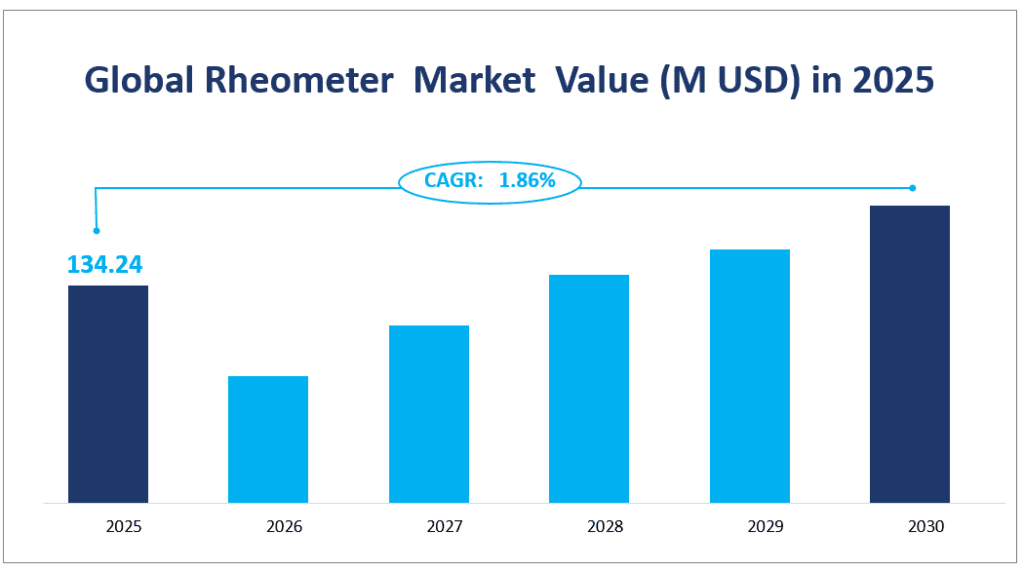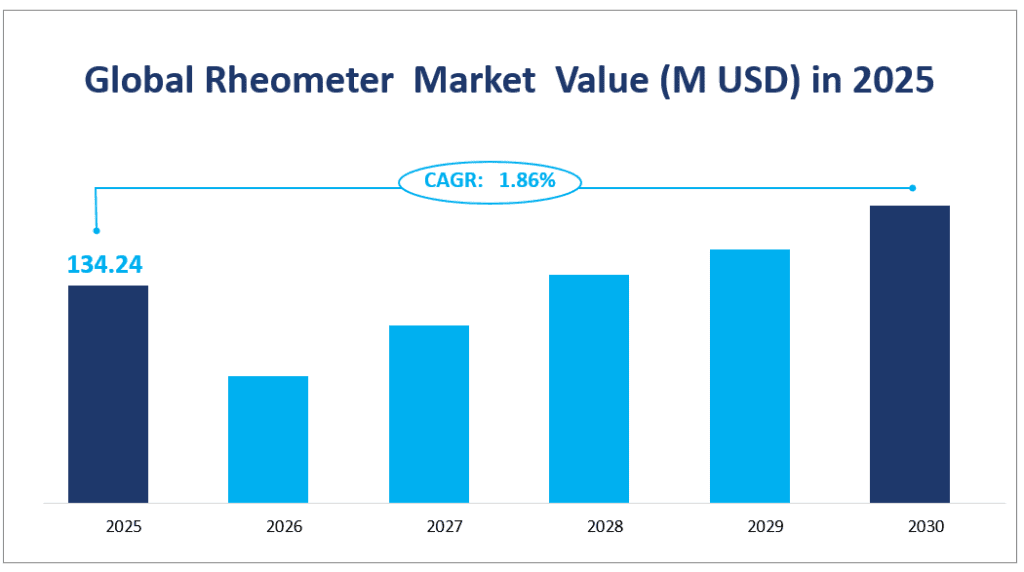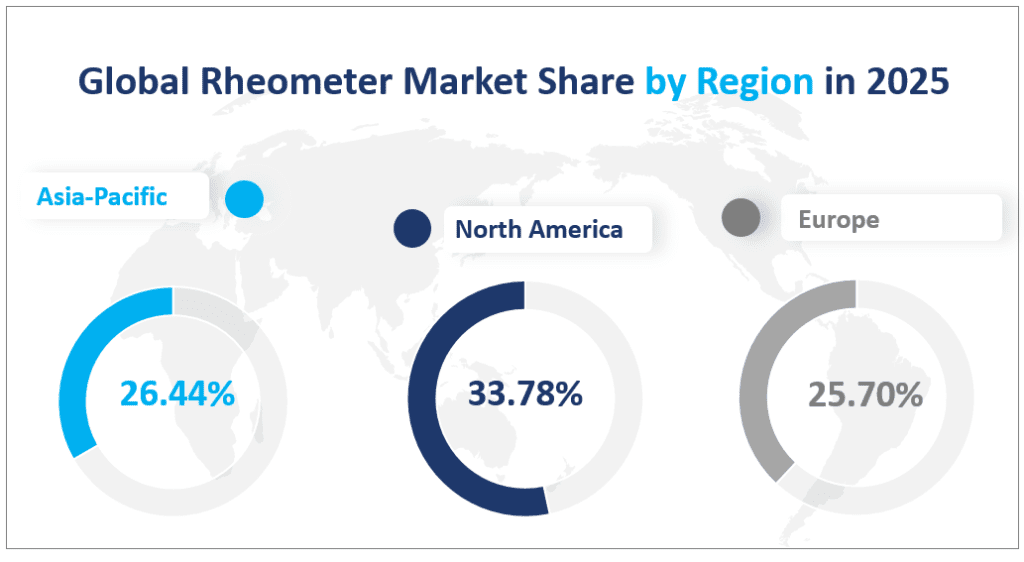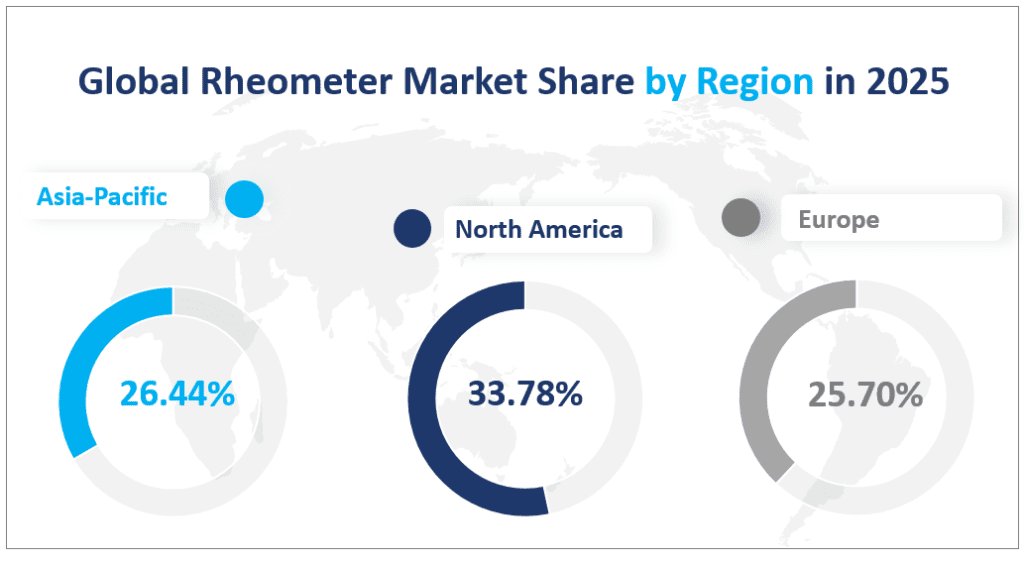1. Global Rheometer Market Revenue and Growth Forecast
In 2025, the global rheometer market is projected to reach a revenue of $134.24 million with a CAGR of 1.86% from 2025 to 2030.
This growth rate indicates a steady expansion of the market, driven by increasing demand from various industries that rely on rheometers for material characterization and quality control.
A rheometer is a precision instrument used to measure the flow properties of liquids and the deformation properties of materials under stress. It is an essential tool in industries such as polymers, petrochemicals, food, cosmetics, and pharmaceuticals. Rheometers provide critical data on viscosity, elasticity, and other rheological properties, which are vital for product development, quality assurance, and process optimization. The ability to measure these properties accurately allows manufacturers to ensure consistent product quality and performance, making rheometers indispensable in modern industrial processes.
Global Rheometer Market Value (M USD) in 2025


2. Driving Factors of the Rheometer Market
Increasing Demand from Key Industries: The primary driver of the rheometer market is the growing demand from industries such as polymers, petrochemicals, food, cosmetics, and pharmaceuticals. These industries rely heavily on rheometers to ensure the quality and performance of their products. For example, in the polymer industry, rheometers are used to measure the viscosity and elasticity of polymer melts, which is crucial for optimizing processing conditions and ensuring product consistency.
Technological Advancements: Advances in rheometer technology have led to the development of more accurate and versatile instruments. Modern rheometers offer enhanced measurement capabilities, improved precision, and user-friendly interfaces, making them more attractive to both existing and potential users. Additionally, the integration of advanced software and data analysis tools has expanded the applications of rheometers, further driving market growth.
Regulatory Compliance: In industries such as pharmaceuticals and cosmetics, strict regulatory requirements necessitate the use of high-quality analytical instruments like rheometers. These regulations ensure product safety and efficacy, driving the demand for reliable and precise rheometers. As regulatory standards become more stringent, the need for advanced rheological testing equipment is expected to increase.
Rising R&D Investments: Companies across various industries are increasing their R&D investments to develop new products and improve existing ones. Rheometers play a crucial role in this process by providing detailed insights into material properties. This increased focus on research and development is expected to drive the demand for rheometers in the coming years.
3. Limiting Factors of the Rheometer Market Growth
High Cost of Instruments: One of the primary challenges facing the rheometer market is the high cost of these instruments. Rheometers are sophisticated devices that require advanced technology and precision engineering, making them expensive to manufacture and purchase. This high cost can be a barrier for small and medium-sized enterprises (SMEs) that may not have the financial resources to invest in such equipment.
Fluctuating Raw Material Prices: The cost of raw materials such as stainless steel, aluminum, and copper, which are essential for manufacturing rheometers, has been volatile in recent years. Fluctuations in raw material prices can impact the profitability of manufacturers and lead to higher product prices, which may deter potential buyers.
Intense Competition: The rheometer market is highly competitive, with several established players and new entrants vying for market share. This competition can lead to price wars and reduced profit margins for manufacturers. Additionally, the proliferation of low-quality or counterfeit products in some regions can undermine the market’s growth and reputation.
Lack of Skilled Operators: The operation and maintenance of rheometers require specialized knowledge and skills. The lack of adequately trained personnel to operate these instruments can limit their adoption, especially in emerging markets. This skills gap can hinder the market’s growth and the effective utilization of rheometers in various industries.
4. Analysis of Rheometer Market Segment
Product Types
Dynamic rheometers are versatile instruments used extensively in research and development settings. They are designed to measure the viscoelastic properties of materials under varying conditions, making them indispensable for industries such as polymers, pharmaceuticals, and cosmetics. In 2025, the dynamic rheometer segment is expected to generate a revenue of $47.96 million. The demand for dynamic rheometers is driven by their ability to provide detailed insights into material behavior, which is crucial for product development and quality control.
Capillary rheometers are specialized instruments designed to measure the flow properties of materials under high shear rates. They are particularly valuable in the polymer industry, where they are used to optimize processing conditions for extrusion, injection molding, and other manufacturing processes. In 2025, capillary rheometers are projected to generate a revenue of $54.58 million. The dominance of capillary rheometers is attributed to their critical role in ensuring the consistency and quality of polymer products.
Torque rheometers are used to study the mixing, plasticization, and thermal stability of materials. They are essential in the development of thermosetting resins, elastomers, and multi-component materials. In 2025, the torque rheometer segment is expected to generate a revenue of $18.20 million. While this segment has a smaller market share compared to dynamic and capillary rheometers, its growth rate indicates a steady increase in demand, driven by advancements in material processing and formulation.
In 2025, the capillary rheometer segment holds the largest market share at 40.66%. This dominance is attributed to its critical role in the polymer industry, where high-shear rate measurements are essential for optimizing processing conditions and ensuring product quality. On the other hand. This growth is driven by the increasing demand for advanced rheological data in research and development across various industries. Dynamic rheometers provide detailed insights into the viscoelastic properties of materials, making them indispensable for product development and quality control.
Market Revenue by Application
Polymers represent a significant portion of the rheometer market, driven by the growing demand for high-performance plastics and polymer-based materials. Rheometers are essential for characterizing the rheological properties of polymer melts, ensuring consistent product quality and optimizing processing conditions. In 2025, the polymers application segment is expected to generate a revenue of $47.00 million.
The petrochemical industry relies on rheometers to measure the viscosity and flow properties of various fluids, including crude oil, lubricants, and petrochemical intermediates. Rheometers play a crucial role in quality control and process optimization in this sector. In 2025, the petrochemicals application segment is projected to generate a revenue of $32.21 million, driven by the ongoing demand for precise rheological data in the petrochemical industry.
The cosmetics and pharmaceuticals industry is a rapidly growing segment, driven by the need for precise rheological data to ensure product stability, texture, and performance. Rheometers play a crucial role in formulating and testing products, contributing to the highest growth rate among all applications. In 2025, the cosmetics and pharmaceuticals application segment is expected to generate a revenue of $29.18 million, reflecting the increasing demand for high-quality products in these industries.
The food industry uses rheometers to measure the viscosity and texture of various products, ensuring consistent quality and consumer satisfaction. Rheometers are essential for optimizing product formulations and ensuring that food products meet quality standards. In 2025, the food application segment is projected to generate a revenue of $13.71 million.
Market Revenue and Share by Segment
| Market Revenue (M USD) in 2025 | Market Share in 2025 | ||
| By Type | Dynamic Rheometer | 47.96 | 35.73% |
| Capillary Rheometer | 54.58 | 40.66% | |
| Torque Rheometer | 18.20 | 13.56% | |
| By Application | Polymers | 47.00 | 35.01% |
| Petrochemicals | 32.21 | 23.99% | |
| Cosmetics and Pharmaceuticals | 29.18 | 21.73% | |
| Food | 13.71 | 10.21% |
5. Regional Rheometer Market
North America remains a dominant region in the global rheometer market, driven by technological advancements, a strong presence of major manufacturers, and increasing demand from industries such as polymers, pharmaceuticals, and food. In 2025, the region is projected to generate a revenue of $45.35 million.
Europe is another significant region in the rheometer market, with a strong industrial base and a focus on high-quality manufacturing. In 2025, Europe is expected to generate a revenue of $34.50 million, driven by increasing demand from the petrochemical and polymer industries. Europe’s market is characterized by a high concentration of precision instrument manufacturers and a growing emphasis on regulatory compliance.
The Asia-Pacific region is emerging as a key player in the global rheometer market, driven by rapid industrialization, urbanization, and increasing demand from various end-use industries. In 2025, the region is projected to generate a revenue of $35.49 million, reflecting a steady expansion driven by the growing polymer, food, and pharmaceutical industries. China, in particular, is expected to be a major driver of growth in this region.
South America is a smaller but growing region in the rheometer market, with Brazil and Argentina being the primary markets. In 2025, the region is projected to generate a revenue of $6.45 million, driven by increasing demand from the petrochemical and food industries. The region’s market is characterized by a growing industrial base and increasing investment in quality control and R&D.
The Middle East and Africa region is characterized by a diverse market with significant contributions from the petrochemical and polymer industries. In 2025, the region is projected to generate a revenue of $12.46 million, driven by increasing demand from the petrochemical and polymer industries. The region’s market is characterized by a growing industrial base and increasing investment in quality control and R&D.
Global Rheometer Market Share by Region in 2025


6. Analysis of the Top 3 Companies in the Rheometer Market
Company Introduction and Business Overview
TA Instruments is a leading provider of thermal analysis and rheology instruments. Established in 1963, the company has a strong presence in the global market, offering a wide range of products for material characterization and quality control. TA Instruments is known for its commitment to innovation and high-performance products, catering to industries such as polymers, pharmaceuticals, and food.
Products Offered
TA Instruments offers a comprehensive range of rheometers, including dynamic rheometers, capillary rheometers, and torque rheometers. Their flagship product, the ARES-G2, is recognized as the industry standard for its accuracy and versatility. The company also provides advanced software solutions for data analysis and process optimization.
Company Introduction and Business Overview
Anton Paar is an Austrian company specializing in the development and production of analytical instruments for laboratories and process analytical technology. Established in 1992, the company has a global presence, offering a wide range of products for material characterization and quality control. Anton Paar is known for its high-quality instruments and commitment to innovation.
Products Offered
Anton Paar offers a variety of rheometers, including the MCR series, which is designed for both routine quality control and high-end R&D applications. Their instruments are characterized by high accuracy, versatility, and user-friendly interfaces. The company also provides advanced accessories and software solutions for comprehensive rheological analysis.
Company Introduction and Business Overview
Thermo Fisher Scientific is a global leader in serving science, providing a wide range of scientific instruments, reagents, and consumables. Established in 1956, the company has a strong presence in the global market, catering to industries such as healthcare, life sciences, and pharmaceuticals. Thermo Fisher Scientific is known for its commitment to innovation and high-quality products.
Products Offered
Thermo Fisher Scientific offers a variety of rheometers, including the HAAKE™ MARS™ iQ Rotational Rheometer, designed for intuitive and reliable rheological measurements. Their instruments are characterized by high accuracy, versatility, and user-friendly interfaces. The company also provides advanced software solutions for data analysis and process optimization.
Major Players
| Company Name | Headquarter | Sales Regions |
| TA Instruments | Germany | Worldwide |
| Anton Paar | Austria | Worldwide |
| Thermo Fisher Scientific | USA | Worldwide |
| Instron | USA | Worldwide |
| A&D Company | Japan | Worldwide |
| Netzsch | Germany | Worldwide |
| Goettfert | Germany | Worldwide |
| Brookfield | USA | Worldwide |
| Freeman Technology | UK | Worldwide |
| Fann Instrument Company | USA | Worldwide |
1 Rheometer Market Overview
1.1 Rheometer Product Overview
1.2 Rheometer Market Segment by Type
1.2.1 Dynamic Rheometer
1.2.2 Capillary Rheometer
1.2.3 Torque Rheometer
1.3 Global Rheometer Market Size by Type (2016-2027)
1.3.1 Global Rheometer Market Size Overview by Type (2016-2027)
1.3.2 Global Rheometer Historic Market Size Review by Type (2016-2021)
1.3.3 Global Rheometer Market Size Forecast by Type (2021-2027)
1.4 Key Regions Market Size Segment by Type (2016-2021)
1.4.1 North America Rheometer Sales Breakdown by Type (2016-2021)
1.4.2 Europe Rheometer Sales Breakdown by Type (2016-2021)
1.4.3 Asia-Pacific Rheometer Sales Breakdown by Type (2016-2021)
1.4.4 South America Rheometer Sales Breakdown by Type (2016-2021)
1.4.5 Middle East and Africa Rheometer Sales Breakdown by Type (2016-2021)
2 Global Rheometer Market Competition by Company
2.1 Global Top Players by Rheometer Sales (2016-2021)
2.2 Global Top Players by Rheometer Value (2016-2021)
2.3 Global Top Players by Rheometer Average Selling Price (ASP) (2016-2021)
2.4 Global Top Manufacturers Rheometer Headquarter, Sales Area
2.5 Rheometer Market Competitive Situation and Trends
2.5.1 Rheometer Market Concentration Rate (2016-2021)
2.5.2 Global 3 and 6 Largest Manufacturers by Rheometer Sales and Revenue in 2020
2.6 Global Top Manufacturers by Company Type (Tier 1, Tier 2 and Tier 3) & (based on the Revenue in Rheometer as of 2019)
2.7 Established Date of Key Manufacturers
2.8 Mergers & Acquisitions, Expansion
3 Global Rheometer Status and Outlook by Region (2016-2027)
3.1 Global Rheometer Market Size and CAGR by Region: 2016 VS 2021 VS 2027
3.2 Global Rheometer Market Size Market Share by Region (2016-2021)
3.2.1 Global Rheometer Sales Market Share by Region (2016-2021)
3.2.2 Global Rheometer Revenue Market Share by Region (2016-2021)
3.3 Global Rheometer Market Size Market Share by Region (2021-2027)
3.3.1 Global Rheometer Sales Market Share by Region (2021-2027)
3.3.2 Global Rheometer Revenue Market Share by Region (2021-2027)
3.3.3 Global Rheometer Sales, Revenue, Price and Gross Margin (2021-2027)
3.4 North America Rheometer Market Size YoY Growth (2016-2027)
3.4.1 North America Rheometer Revenue YoY Growth (2016-2027)
3.4.2 North America Rheometer Sales YoY Growth (2016-2027)
3.5 Asia-Pacific Rheometer Market Size YoY Growth (2016-2027)
3.5.1 Asia-Pacific Rheometer Revenue YoY Growth (2016-2027)
3.5.2 Asia-Pacific Rheometer Sales YoY Growth (2016-2027)
3.6 Europe Rheometer Market Size YoY Growth (2016-2027)
3.6.1 Europe Rheometer Revenue YoY Growth (2016-2027)
3.6.2 Europe Rheometer Sales YoY Growth (2016-2027)
3.7 South America Rheometer Market Size YoY Growth (2016-2027)
3.7.1 South America Rheometer Revenue YoY Growth (2016-2027)
3.7.2 South America Rheometer Sales YoY Growth (2016-2027)
3.8 Middle East and Africa Rheometer Market Size YoY Growth (2016-2027)
3.8.1 Middle East and Africa Rheometer Revenue YoY Growth (2016-2027)
3.8.2 Middle East and Africa Rheometer Sales YoY Growth (2016-2027)
4 Global Rheometer by Application
4.1 Rheometer Market Segment by Application
4.1.1 Polymers
4.1.2 Petrochemicals
4.1.3 Food
4.1.4 Cosmetics and Pharmaceuticals
4.2 Global Rheometer Value by Application: 2016 VS 2021 VS 2027
4.3 Global Rheometer Historic Value by Application (2016-2021)
4.4 Global Rheometer Forecasted Value by Application (2021-2027)
5 North America Rheometer Market Size by Country
5.1 North America Rheometer Market Size Market Share by Country (2016-2021)
5.1.1 North America Rheometer Sales Market Share by Country (2016-2021)
5.1.2 North America Rheometer Revenue Market Share by Country (2016-2021)
5.2 North America Rheometer Market Size Market Share by Country (2021-2027)
5.2.1 North America Rheometer Sales Market Share by Country (2021-2027)
5.2.2 North America Rheometer Revenue Market Share by Country (2021-2027)
5.3 North America Market Size (Units) and YoY Growth by Country
5.3.1 U.S. Rheometer Market Size (Units) and YoY Growth (2016-2021)
5.3.2 Canada Rheometer Market Size (Units) and YoY Growth (2016-2021)
5.3.2 Mexico Rheometer Market Size (Units) and YoY Growth (2016-2021)
6 Europe Rheometer Market Size by Country
6.1 Europe Rheometer Market Size Market Share by Country (2016-2021)
6.1.1 Europe Rheometer Sales Market Share by Country (2016-2021)
6.1.2 Europe Rheometer Revenue Market Share by Country (2016-2021)
6.2 Europe Rheometer Market Size Market Share by Country (2021-2027)
6.2.1 Europe Rheometer Sales Market Share by Country (2021-2027)
6.2.2 Europe Rheometer Revenue Market Share by Country (2021-2027)
6.3 Europe Market Size YoY Growth by Country
6.3.1 Germany Rheometer Market Size YoY Growth (2016-2021)
6.3.2 France Rheometer Market Size YoY Growth (2016-2021)
6.3.3 U.K. Rheometer Market Size YoY Growth (2016-2021)
6.3.4 Italy Rheometer Market Size YoY Growth (2016-2021)
6.3.5 Russia Rheometer Market Size YoY Growth (2016-2021)
7 Asia-Pacific Rheometer Market Size by Country
7.1 Asia-Pacific Rheometer Market Size Market Share by Country (2016-2021)
7.1.1 Asia-Pacific Rheometer Sales Market Share by Country (2016-2021)
7.1.2 Asia-Pacific Rheometer Revenue Market Share by Country (2016-2021)
7.2 Asia-Pacific Rheometer Market Size Market Share by Country (2021-2027)
7.2.1 Asia-Pacific Rheometer Sales Market Share by Country (2021-2027)
7.2.2 Asia-Pacific Rheometer Revenue Market Share by Country (2021-2027)
7.3 Asia-Pacific Market Size YoY Growth by Country
7.3.1 China Rheometer Market Size YoY Growth (2016-2021)
7.3.2 Japan Rheometer Market Size YoY Growth (2016-2021)
7.3.3 Southeast Asia Rheometer Market Size YoY Growth (2016-2021)
7.3.4 South Korea Rheometer Market Size YoY Growth (2016-2021)
8 South America Rheometer Market Size by Country
8.1 South America Rheometer Market Size Market Share by Country (2016-2021)
8.1.1 South America Rheometer Sales Market Share by Country (2016-2021)
8.1.2 South America Rheometer Revenue Market Share by Country (2016-2021)
8.2 South America Rheometer Market Size Market Share by Country (2021-2027)
8.2.1 South America Rheometer Sales Market Share by Country (2021-2027)
8.2.2 South America Rheometer Revenue Market Share by Country (2021-2027)
8.3 South America Market Size YoY Growth by Country
8.3.1 Brazil Rheometer Market Size YoY Growth (2016-2021)
8.3.2 Argentina Rheometer Market Size YoY Growth (2016-2021)
9 Middle East and Africa Rheometer Market Size by Country
9.1 Middle East and Africa Rheometer Market Size Market Share by Country (2016-2021)
9.1.1 Middle East and Africa Rheometer Sales Market Share by Country (2016-2021)
9.1.2 Middle East and Africa Rheometer Revenue Market Share by Country (2016-2021)
9.2 Middle East and Africa Rheometer Market Size Market Share by Country (2021-2027)
9.2.1 Middle East and Africa Rheometer Sales Market Share by Country (2021-2027)
9.2.2 Middle East and Africa Rheometer Revenue Market Share by Country (2021-2027)
9.3 Middle East and Africa Market Size YoY Growth by Country
9.3.1 Turkey Rheometer Market Size YoY Growth (2016-2021)
9.3.2 Saudi Arabia Rheometer Market Size YoY Growth (2016-2021)
9.3.3 U.A.E Rheometer Market Size YoY Growth (2016-2021)
10 Providers Profiles
10.1 TA Instruments
10.1.1 TA Instruments Corporation Information
10.1.2 TA Instruments Business Overview
10.1.3 TA Instruments Rheometer Sales, Price, Revenue, Gross, Gross Margin
10.1.4 TA Instruments Rheometer Products Offered
10.1.5 TA Instruments Rheometer Recent Development
10.2 Anton Paar
10.2.1 Anton Paar Corporation Information
10.2.2 Anton Paar Business Overview
10.2.3 Anton Paar Rheometer Sales, Price, Revenue, Gross, Gross Margin
10.2.4 Anton Paar Rheometer Products Offered
10.2.5 Anton Paar Rheometer Recent Development
10.3 Thermo fisher Scientific
10.3.1 Thermo fisher Scientific Corporation Information
10.3.2 Thermo fisher Scientific Business Overview
10.3.3 Thermo fisher Scientific Rheometer Sales, Price, Revenue, Gross, Gross Margin
10.3.4 Thermo fisher Scientific Rheometer Products Offered
10.3.5 Thermo fisher Scientific Rheometer Recent Development
10.4 Instron
10.4.1 Instron Corporation Information
10.4.2 Instron Business Overview
10.4.3 Instron Rheometer Sales, Price, Revenue, Gross, Gross Margin
10.4.4 Instron Rheometer Products Offered
10.5 A&D Company
10.5.1 A&D Company Corporation Information
10.5.2 A&D Company Business Overview
10.5.3 A&D Company Rheometer Sales, Price, Revenue, Gross, Gross Margin
10.5.4 A&D Company Rheometer Products Offered
10.5.5 A&D Company Rheometer Recent Development
10.6 Netzsch
10.6.1 Netzsch Corporation Information
10.6.2 Netzsch Business Overview
10.6.3 Netzsch Rheometer Sales, Price, Revenue, Gross, Gross Margin
10.6.4 Netzsch Rheometer Products Offered
10.6.5 Netzsch Rheometer Recent Development
10.7 Goettfert
10.7.1 Goettfert Corporation Information
10.7.2 Goettfert Business Overview
10.7.3 Goettfert Rheometer Sales, Price, Revenue, Gross, Gross Margin
10.7.4 Goettfert Rheometer Products Offered
10.8 Brookfield
10.8.1 Brookfield Corporation Information
10.8.2 Brookfield Business Overview
10.8.3 Brookfield Rheometer Sales, Price, Revenue, Gross, Gross Margin
10.8.4 Brookfield Rheometer Products Offered
10.8.5 Brookfield Rheometer Recent Development
10.9 Freeman Technology
10.9.1 Freeman Technology Corporation Information
10.9.2 Freeman Technology Business Overview
10.9.3 Freeman Technology Rheometer Sales, Price, Revenue, Gross, Gross Margin
10.9.4 Freeman Technology Rheometer Products Offered
10.9.5 Freeman Technology Rheometer Recent Development
10.10 Fann Instrument Company
10.10.1 Fann Instrument Company Corporation Information
10.10.2 Fann Instrument Company Business Overview
10.10.3 Fann Instrument Company Rheometer Sales, Price, Revenue, Gross, Gross Margin
10.10.4 Fann Instrument Company Rheometer Products Offered
11 Rheometer Upstream, Opportunities, Challenges, Risks and Influences Factors Analysis
11.1 Rheometer Key Raw Materials
11.1.1 Key Raw Materials
11.1.2 Key Raw Materials Price
11.1.3 Raw Materials Key Suppliers
11.2 Manufacturing Cost Structure
11.2.1 Raw Materials
11.2.2 Labor Cost
11.2.3 Manufacturing Expenses
11.3 Rheometer Industrial Chain Analysis
11.4 Market Opportunities, Challenges, Risks and Influences Factors Analysis
11.4.1 Market Opportunities and Drivers
11.4.2 Market Challenges
11.4.3 Market Risks
11.4.4 Porter’s Five Forces Analysis
12 Marketing Strategy Analysis, Distributors
12.1 Sales Channel
12.2 Rheometer Distributors List
12.3 Rheometer Customers
13 Research Findings and Conclusion
14 Appendix
14.1 Methodology
14.2 Research Data Source
